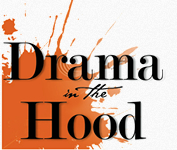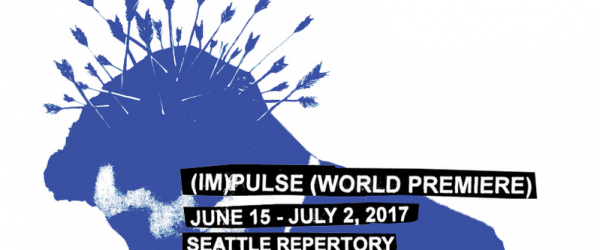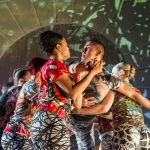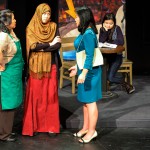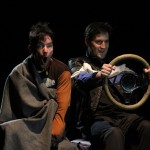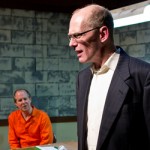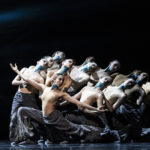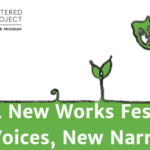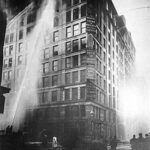Spectrum’s Dance Company’s “Theater of Disruption” lives up to that handle with dual World Premieres
Cruel, life-changing, and—too often—deadly violence suffered by LGBTQ people formed the basis for this 90 minute dance/dramatic performance by the Spectrum Dance Company + Donald Byrd. Though the press release mentions the killing of 49 people and injuring of 58 others in the machine gun attack by Omar Mateen a year ago at the Pulse nightclub in Orlando, Byrd drew upon the sadder and much older outlaw “tradition” of anti-gay violence. Evoking the artistic monologuist styles that emerged in the 1990s during the peak of the AIDS Plague, Byrd continued his exploration of a “theater of disruption.” This style of theater uses all the tools available for performance on stage to, in Byrd’s words, “engage audiences in issues that are difficult and intractable, and importantly to move closer to disrupting the artificial and often arbitrary boundaries between dance and theater.”
In the Leo K Theatre at Seattle Rep, a near capacity audience at opening night watched the remarkable Spectrum dancers present this new work. Byrd organized the show into two sections. At the opening of Part One, we see the wild exuberance of the gay party scene, and one of the best segments is watching the male members of the company strut their stuff in a cat walk sequence. The music by Bob Ostertag and performed by Kronos Quartet is staccato and repetitive as often dance-party music is. The dancers wear white tights with random dark lines and t-shirt tops with spectacular graffiti designs. I think those shirts by Costume Designer Doris Black (see comments) would get a nice price at auction because they were so “fagulous,” to use a term from later in the show.
But the partying is brought up short by anti-gay violence. This is not an “issue” or a headline; its people’s lives. From this moment on, the show relentlessly makes it clear that this violence hurts, even kills real humans, real people. We hear David Wojnarowicz’s text from Being Queer in America: A Journal of Disintegration repeated several times—by recorded narration and also by one of the dancers, and lastly a projection on the back wall of Wojnarowicz reading it. This harrowing excerpt describes an incident of a gay man being beaten by a car-full of thugs while a crowd on mostly male onlookers did nothing. A friend escaped, ran home, and did not call the police. We watch as dancers fall, mimic being beaten, and fold in a fetal position to protect vital organs.
The dancers change costumes to gray hospital gowns as the show transitions into Part Two. Most of Part Two is actor Craig MacArthur performing a non-stop monologue. This is the world premiere of parts of Marrow by Brian Quirk. The nameless character lies in a coma with a black eye and bloody face. The monologue brings us inside his head as a clear and lucid part of his brain attempts to coach memory, sensation, connection, anything out of the comatose parts. Occasionally he jerks violently during seizures. During this time, there’s the steady beep-beep of the heart monitoring machine, and sometimes his image is project across his body making the experience of watching him a dual one: the projection made his suffering very large and close up while looking directing at him brought some distance.
This is the extended story of a young dancer who gay-haters beat into a coma with a pipe. Byrd and Quirk deliberately held our attention on this story of suffering and halting attempts to walk again, to remember again, to recall the loves of his life again. Just when you think it must stop, it doesn’t and continues. But that’s Byrd’s point, being in the audience is a safe place to allow oneself to deal with these feelings of outrage, discomfort, compassion, helplessness, sorrow, anger, etc. Out on the streets in public view, if one is different from what any random person or groups of persons prone to cruel acts thinks, one is continually at risk. Being in public, or even a private dance club, exposes LGBTQ people to great risks of physical violence every day.
This show is disruptive, and it is well worth your attention.
This is the final installment of 3 World Premiere productions included in Spectrum’s 2016-2017 season—AMERICAN: Race, Identity or Culture? They all deal with seemingly intractable issues: Shot, reviewed Jan. 20th, dealt with police shootings of unarmed black people, Rambunctious Iteration #3, returned by popular demand in March to explore the music of Immigrant-American classical composers; and now (Im)Pulse, a world premiere dramatic dance-theater response to the Orlando Pulse Nightclub tragedy and the ongoing aggression towards LBGTQ people.
The Company: Craig MacArthur* | Alex Cozier | Blair Jolly Elliot | Paul Giarrantano | Nia-Amina Minor | Robert Moore | Madison Oliver | Alexander Pham | Emily Philaja | Andrew Pontius | Fausto Rivera | Mary Sigward | Lena Silverman | Jaclyn Wheatley | Sherman D. Wood
* Member of Actors’ Equity Association.
Production Team: Donald Byrd, Choreography and Direction | Brian Quirk, Text | Jack Mehler, Lighting and Scenic Design | Robertson Witmer, Sound Design | Travis Mouffe, Projection Design | Doris Black, Costume Design | Melanie White, Stage Manager
(IM)Pulse by Spectrum Dance Company + Donald Bryd. Runtime: 85 minutes, no intermission. Seattle Repertory Theatre, Leo K. Theatre, 155 Mercer St, Seattle, 98109, in Seattle Center. 7: 30 PM Thurs – Sat; 2 PM Sun. Tickets: seattlerep.org/Buy/Tickets/Production/6306 Info: https://www.seattlerep.org/ or (206) 443-2222. Runs June 15 – July 2.
Comments:
6/19/17… The costumer design was initially inspired by the work of Shawn McQuate (his images are projected in part 1 of the show) – but Doris Black (costumer designer) felt because his work was pen and ink, it would be too dark. Moving forward, Doris was really inspired by the work of photographer Robert Carrithers and the work he did for a series on Club 57 during its heyday in New York. You can peruse some of his photos here: http://www.robertcarrithers.com/club-57/page/6/
